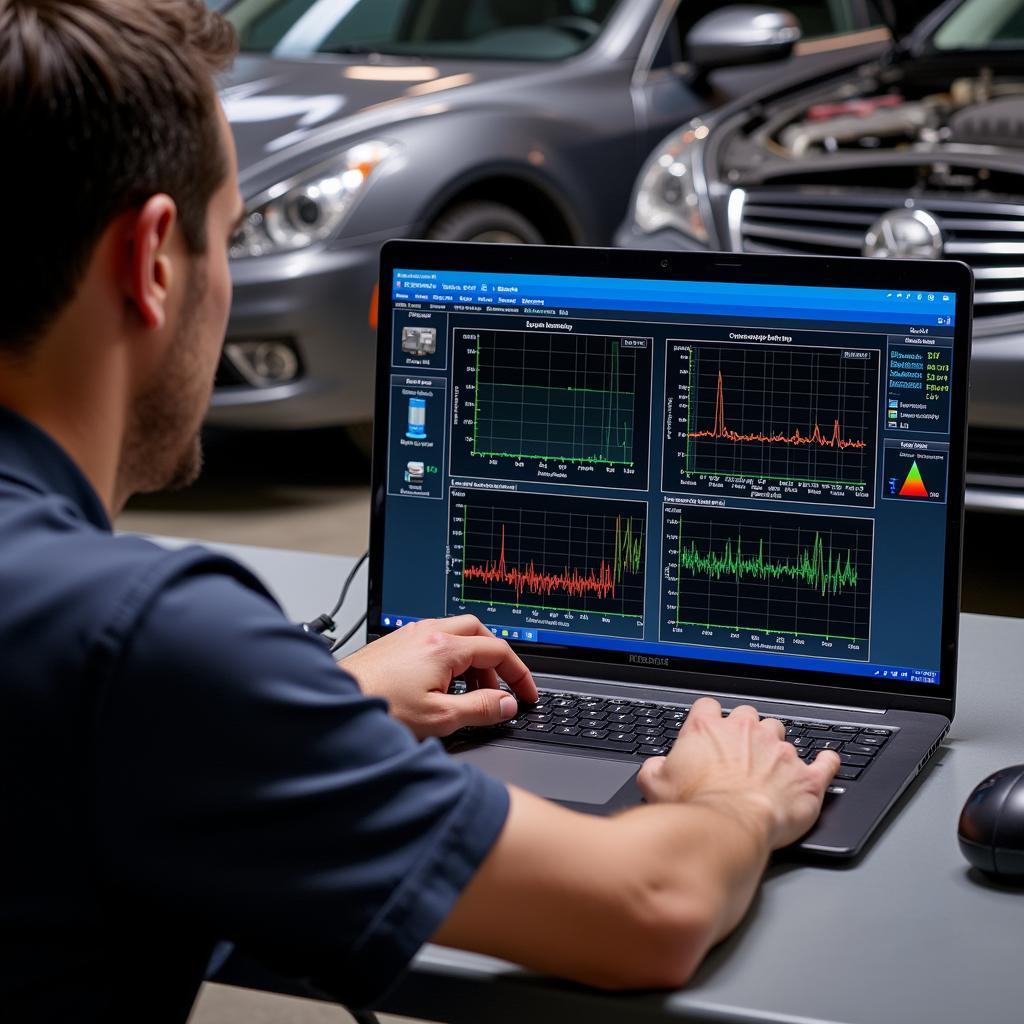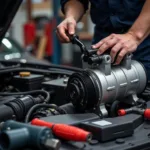Car diagnostic software for timings is essential for modern vehicle maintenance and repair. It allows mechanics to delve deep into a vehicle’s engine control unit (ECU) and analyze critical timing parameters, ensuring optimal performance and fuel efficiency. Choosing the right software can significantly impact a workshop’s efficiency and diagnostic capabilities. This guide explores the importance of timing analysis, the different types of car diagnostic software available, and key features to consider when selecting the right tool for your needs.
Understanding the Importance of Engine Timings
Accurate engine timing is crucial for the smooth and efficient operation of any vehicle. It dictates when the valves open and close in relation to the piston’s position, ensuring the proper intake of air and fuel, and the expulsion of exhaust gases. Incorrect timings can lead to a variety of issues, including reduced power output, poor fuel economy, and increased emissions. In severe cases, it can even cause catastrophic engine damage. Therefore, precise diagnosis and adjustment of engine timings are paramount for maintaining vehicle performance and longevity.
Types of Car Diagnostic Software for Timings
Several types of car diagnostic software cater to different needs and budgets. These range from basic OBD-II code readers to sophisticated professional-grade systems.
OBD-II Code Readers
These are entry-level diagnostic tools that can read and clear basic diagnostic trouble codes (DTCs). While some can provide limited timing information, they are generally insufficient for in-depth timing analysis.
Dedicated Timing Analysis Software
This specialized software focuses specifically on engine timing and provides detailed data on parameters such as ignition timing, camshaft timing, and crankshaft position. It often includes advanced features like waveform analysis and data logging.
OEM Diagnostic Software
Original Equipment Manufacturer (OEM) software is designed specifically for a particular vehicle make or model. It offers the most comprehensive diagnostic capabilities, including access to proprietary data and functions not available in generic software.
Multi-brand Diagnostic Software
These versatile tools support a wide range of vehicle makes and models, offering a cost-effective solution for workshops that work on diverse vehicles. They provide a balance between functionality and affordability.
Key Features to Consider When Choosing Car Diagnostic Software
When selecting car diagnostic software for timings, consider the following key features:
- Vehicle Coverage: Ensure the software supports the makes and models you commonly work on.
- Timing-Specific Functionality: Look for features like waveform analysis, data logging, and the ability to adjust timing parameters.
- User Interface: A user-friendly interface can significantly improve efficiency and reduce diagnostic time.
- Updates and Support: Regular software updates are essential for staying current with the latest vehicle technologies. Reliable technical support can be invaluable when encountering issues.
- Cost: Balance the features and capabilities with your budget.
How Car Diagnostic Software Helps with Timings
Car diagnostic software for timings offers numerous benefits:
- Accurate Diagnostics: Precisely identify timing-related issues.
- Efficient Repairs: Streamline the repair process by pinpointing the root cause of problems.
- Improved Performance: Optimize engine performance by fine-tuning timing parameters.
- Reduced Emissions: Ensure compliance with emissions regulations.
- Enhanced Customer Satisfaction: Provide faster and more effective service.
“Investing in quality car diagnostic software is crucial for any modern workshop. It’s the key to accurately diagnosing and efficiently repairing complex timing-related issues,” says John Miller, Senior Automotive Technician at Miller’s Auto Repair. “The ability to analyze waveforms and log data provides invaluable insights into engine performance.”
Timing Belt vs. Timing Chain Diagnostics
Understanding the difference between timing belt and timing chain diagnostics is important. While both perform the same function, they have different lifespans and failure modes. Diagnostic software can help identify issues specific to each system.
Timing Belt Diagnostics
- Signs of Wear: Software can detect subtle changes in timing that may indicate belt wear.
- Predictive Maintenance: Analyze data to anticipate belt failure and prevent costly repairs.
Timing Chain Diagnostics
- Chain Stretch: Diagnose chain stretch and other related issues.
- Tensioner Problems: Identify problems with the chain tensioner.
“Using diagnostic software allows us to proactively address timing issues before they become major problems,” adds Sarah Johnson, Lead Diagnostic Technician at Johnson Automotive. “This not only saves our customers money but also ensures their vehicles are running at peak performance.”
Conclusion
Car diagnostic software for timings is an indispensable tool for modern car repair. Investing in the right software can significantly improve diagnostic accuracy, efficiency, and ultimately, customer satisfaction. By carefully considering the features and capabilities discussed in this guide, you can choose the best software to meet your specific needs and enhance your workshop’s capabilities. Remember that accurate timing is essential for optimal vehicle performance and longevity.
FAQ
- What is the best car diagnostic software for timings? The best software depends on your specific needs and budget.
- How often should I update my diagnostic software? Regular updates are crucial for staying compatible with the latest vehicles.
- Can I use diagnostic software to adjust timing myself? While possible, it’s recommended to consult a qualified technician.
- What is the difference between OBD-II and OEM software? OEM software offers more comprehensive diagnostics for specific makes and models.
- How much does car diagnostic software cost? Prices vary depending on features and capabilities.
- What are the common symptoms of bad timing? Symptoms include rough idling, reduced power, and poor fuel economy.
- Can diagnostic software prevent engine damage? Yes, by identifying timing issues early, software can help prevent costly damage.
For further assistance, please contact us via WhatsApp: +1(641)206-8880, or Email: [email protected]. We offer 24/7 customer support. We also have other helpful articles on our website related to car diagnostics and repair. Check out our blog for more information on how to choose the right diagnostic tools and troubleshooting common car problems.



